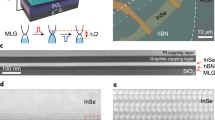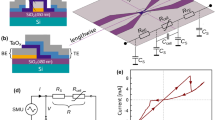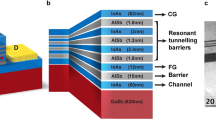Abstract
The possibility of fabricating electronic devices with functional building blocks of atomic size is a major driving force of nanotechnology1. The key elements in electronic circuits are switches, usually realized by transistors, which can be configured to perform memory operations. Electronic switches have been miniaturized all the way down to the atomic scale2,3,4,5,6,7,8,9. However, at such scales, three-terminal devices are technically challenging to implement. Here we show that a metallic atomic-scale contact can be operated as a reliable and fatigue-resistant two-terminal switch. We apply a careful electromigration protocol to toggle the conductance of an aluminium atomic contact between two well-defined values in the range of a few conductance quanta. Using the nonlinearities of the current–voltage characteristics caused by superconductivity10 in combination with molecular dynamics and quantum transport calculations, we provide evidence that the switching process is caused by the reversible rearrangement of single atoms. Owing to its hysteretic behaviour with two distinct states, this two-terminal switch can be used as a non-volatile information storage element.
This is a preview of subscription content, access via your institution
Access options
Subscribe to this journal
Receive 12 print issues and online access
$259.00 per year
only $21.58 per issue
Buy this article
- Purchase on Springer Link
- Instant access to full article PDF
Prices may be subject to local taxes which are calculated during checkout





Similar content being viewed by others
References
Waser, R. Nanoelectronics and Information Technology (Wiley-VCH, 2003).
Park, J. et al. Coulomb blockade and the Kondo effect in single-atom transistors. Nature 417, 722–725 (2002).
Liang, W., Shores, M. P., Bockrath, M., Long, J. R. & Park, H. Kondo resonance in a single-molecule transistor, Nature 417, 725–729 (2002).
Kubatkin, S. et al. Single-electron transistor of a single organic molecule with access to several redox states. Nature 425, 698–701 (2003).
Moth-Poulsen, K. & Bjørnholm, T. Molecular electronics with single molecules in solid-state devices. Nature Nanotech. 4, 551–556 (2009).
Champagne, A. R., Pasupathy, A. N. & Ralph, D. C. Mechanically adjustable and electrically gated single-molecule transistors. Nano Lett. 5, 305–308 (2005).
Martin, C. A., Smit, R. H. M., van der Zant, H. S. J. & van Ruitenbeek, J. M. A nanoelectromechanical single-atom switch. Nano Lett. 9, 2940–2945 (2009).
Ballmann, S. & Weber, H. B. An electrostatic gate for mechanically controlled single-molecule junctions. New J. Phys. 14, 123028 (2012).
Fuechsle, M. et al. A single-atom transistor. Nature Nanotech. 7, 242–246 (2012).
Scheer, E., Joyez, P., Esteve, D., Urbina, C. & Devoret, M. H. Conduction channel transmissions of atomic-size aluminum contacts. Phys. Rev. Lett. 78, 3535–3538 (1997).
Agraït, N., Yeyati, A. L. & van Ruitenbeek, J. M. Quantum properties of atomic-sized conductors. Phys. Rep. 377, 81–279 (2003).
Scheer, E. et al. The signature of chemical valence in the electrical conduction through a single-atom contact. Nature 394, 154–157 (1998).
Hasegawa, T., Terabe, K., Tsuruoka, T. & Aono, M. Atomic switch: atom/ion movement controlled devices for beyond von-Neumann computers. Adv. Mater. 24, 252–267 (2012).
Van der Molen, S. J. & Liljeroth, P. Charge transport through molecular switches. J. Phys. 22, 133001 (2010).
Miyamachi, T. et al. Robust spin crossover and memristance across a single molecule. Nature Commun. 3, 938 (2012).
Quek, S. Y. et al. Mechanically controlled binary conductance switching of a single-molecule junction. Nature Nanotech. 4, 230–234 (2009).
Smith, D. P. E. Quantum point contact switches. Science 269, 371–373 (1995).
Sabater, C., Untiedt, C., Palacios, J. J. & Caturla, M. J. Mechanical annealing of metallic electrodes at the atomic scale. Phys. Rev. Lett. 108, 205502 (2012).
Terabe, K., Hasegawa, T., Nakayama T. & Aono, M. Quantized conductance atomic switch. Nature 433, 47–50 (2005).
Geresdi A. et al. From stochastic single atomic switch to nanoscale resistive memory device. Nanoscale 3, 1504–1507 (2011).
Xie, F.-Q. et al. Atomic transistors with predefined quantum conductance by reversible contact reconstruction. Nano Lett. 8, 4493–4497 (2008).
Van den Brom, H. E., Yanson, A. I. & van Ruitenbeek, J. M. Characterization of individual conductance steps in metallic quantum point contacts. Physica B 252, 69–75 (1998).
Park, H., Lim, A. K. L., Alivisatos, A. P., Park, J. & McEuen, P. L. Fabrication of metallic electrodes with nanometer separation by electromigration. Appl. Phys. Lett. 75, 301–303 (1999).
Yanson, I. A. & van Ruitenbeek, J. M. Do histograms constitute a proof for conductance quantization? Phys. Rev. Lett. 79, 2157–2160 (1997).
Cuevas, J. C., Yeyati, A. L. & Martín-Rodero, A. Microscopic origin of conducting channels in metallic atomic-size contacts. Phys. Rev. Lett. 80, 1066–1069 (1998).
Makk, P., Csonka, S. & Halbritter, A. Effect of hydrogen molecules on the electronic transport through atomic-sized metallic junctions in the superconducting state. Phys. Rev. B 78, 045414 (2008).
Pauly, F. et al. Theoretical analysis of the conductance histograms and structural properties of Ag, Pt, and Ni nanocontacts. Phys. Rev. B 74, 235106 (2006).
Todorov, T. N., Hoekstra, J. & Sutton, A. Current-induced embrittlement of atomic wires. Phys. Rev. Lett. 86, 3606–3609 (2001).
Brandbyge, M., Stokbro, K., Taylor, J., Mozos, J.-L. & Ordejón, P. Origin of current-induced forces in an atomic gold wire: a first-principles study. Phys. Rev. B 67, 193104 (2003).
Lü, J. T., Brandbyge, M. & Hedegård, P. Blowing the fuse: Berry's phase and runaway vibrations in molecular conductors. Nano Lett. 10, 1657–1663 (2010).
Kuekes, P. J., Stewart, D. R. & Williams, R. S. The crossbar latch: logic value storage, restoration, and inversion in crossbar circuits. J. Appl. Phys. 97, 034301 (2005).
Acknowledgements
The authors thank H-F. Pernau for experimental assistance and M. Häfner and O. Schecker for their contributions in the early phase of this study. The authors also thank P. Leiderer for disussions. This work was supported financially by the DFG (through SFB 513 and SFB 767) and by the Baden-Württemberg Stiftung (through research network ‘Functional Nanostructures’). F.P. acknowledges additional funding through the Carl Zeiss Foundation. The authors thank the NIC for computer time.
Author information
Authors and Affiliations
Contributions
C.S. performed the experiments. M.M. conducted the calculations and theoretical modelling. F.P., J.C.C., P.N. and E.S. planned the project and advised the students. All authors discussed the results and prepared the manuscript.
Corresponding author
Ethics declarations
Competing interests
The authors declare no competing financial interests.
Supplementary information
Supplementary information
Supplementary Information (PDF 7325 kb)
Rights and permissions
About this article
Cite this article
Schirm, C., Matt, M., Pauly, F. et al. A current-driven single-atom memory. Nature Nanotech 8, 645–648 (2013). https://doi.org/10.1038/nnano.2013.170
Received:
Accepted:
Published:
Issue Date:
DOI: https://doi.org/10.1038/nnano.2013.170
This article is cited by
-
Atomic switches of metallic point contacts by plasmonic heating
Light: Science & Applications (2019)
-
Fabrication of atomic junctions with experimental parameters optimized using ground-state searches of Ising spin computing
Scientific Reports (2019)
-
Coulomb Blockade and Multiple Andreev Reflection in a Superconducting Single-Electron Transistor
Journal of Low Temperature Physics (2018)
-
Towards single-molecule optoelectronic devices
Science China Chemistry (2018)
-
Controlling the thermoelectric effect by mechanical manipulation of the electron’s quantum phase in atomic junctions
Scientific Reports (2017)



